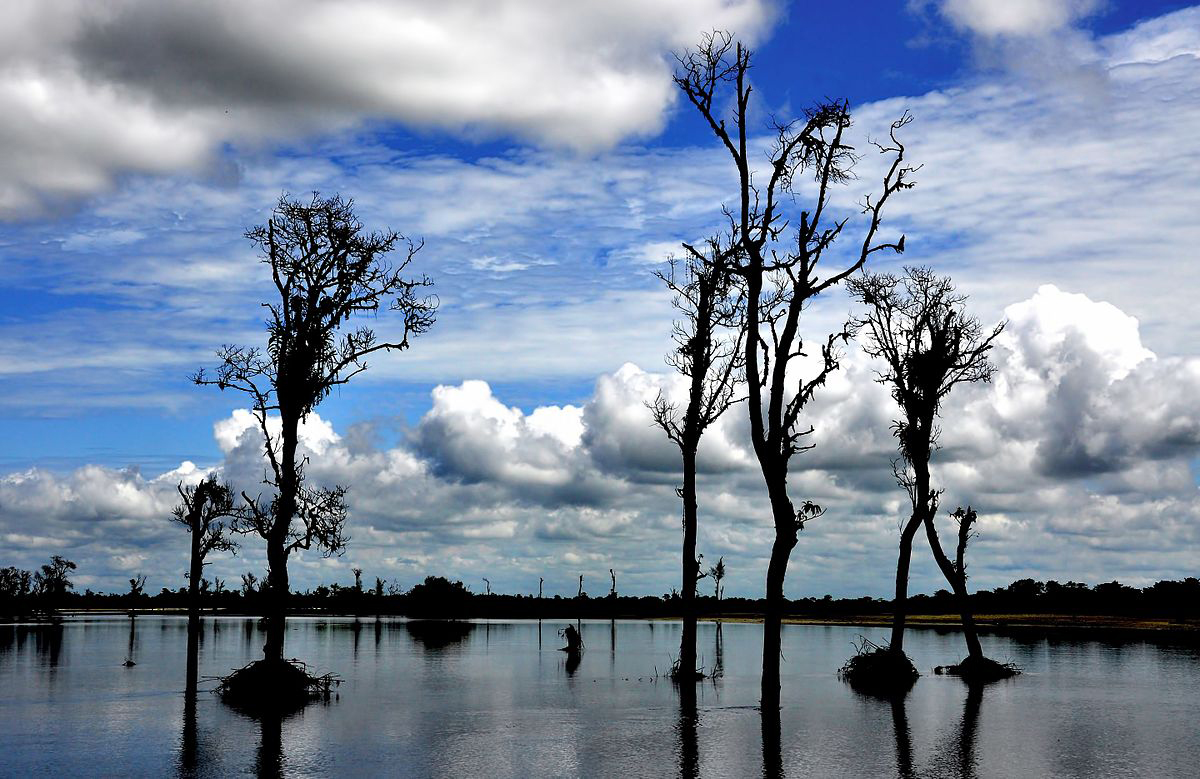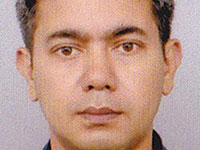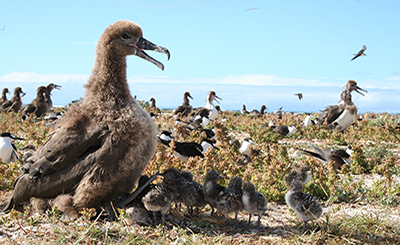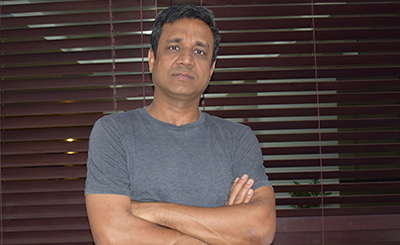
A short story by the author of the Detective Arjun Arora series. His latest novel, The Forest Beneath The Mountains, will be published by Speaking Tiger in January 2021. Curated by Palash Krishna Mehrotra.
Jayanta Borkotoki, an ACS or Assam Civil Service officer posted in a town in Upper Assam, had always wanted to be a writer. He had even dreamt of becoming famous, travelling the world, and living off his writing. Reality slowly intervened, and after his father had passed away, he started looking for a job in earnest, and was lucky to land one in the ACS (there were recommendations from family friends and some money changed hands, but that was normal and expected).
He turned out to be a conscientious officer, doing his work to the best of his ability. But he didn’t overexert himself; it was after all still the land of lahe lahe, or “slowly slowly”, and besides, as a government officer, he soon came to realise that life would go on, with or without his efforts. The only writing he did nowadays were reports and comments on official files.
After he had bid farewell to Delhi (where he had gone from his hometown of Tezpur after school to do his graduation and masters), and before getting into the ACS, Jayanta had worked for a while as a freelance journalist based in Guwahati. He had done stories for websites and magazines and newspapers, nearly all of them based in the metro cities.
What had they been about? He hardly remembered anymore. He had travelled a lot though, for those stories, and that was what remained with him: a vague memory of crumbling roads and ramshackle accommodation and (mostly) bad food and vile spirits. They seemed like things from another life now. There was, however, one story which he could never forget, maybe because he never wrote it in the end.
Assam in the summer: towering clouds, a dazzling white, piled up in the sky while the sun was blazing down and the humidity rising up from the damp earth and the flooded paddy fields. The rain, when it finally came, would offer but temporary respite. The floodwaters had receded, leaving behind wrecked homes and fields buried in sand.
Jayanta looked at the photos during the three-hour drive from Guwahati. He had earlier seen them on television. One of a girl in her mid-teens dressed in traditional Bodo wear, a green dokhona or high sarong and a yellow aronoi or scarf over her blouse, smiling on the porch of her modest house with its earthen floor and tin roof. Another photo showed her sprawled out on the green undergrowth, her T-shirt soaked in blood, her legs sideways and her arms flung out, wearing a checked skirt, her feet bare.
They had made her kneel and shot her in the back, then turned her over with their feet and shot her again, even pushed a gun barrel into her mouth and pulled the trigger. Photos of the boys who had done the deed, well-built youth dressed in black knee-length shorts and T-shirts or camouflage pants and shirts, shoulder-length hair, tied-up in some cases, carrying AKs or M16s, some fitted with UBGLs. The cellphone video, which they themselves had shot and circulated (and from which the journalist in Guwahati had printed these blurry photos), showed one of them firing a few rounds in the air as the girl’s father and a few villagers stood around helplessly. The girl was just a Class 10 student.
It was a nondescript little town to the east of Kokrajhar; in a north-east direction lay Manas national park. The district was Chirang, one of the poorest in Assam, part of the BTAD or Bodoland Territorial Area Districts; across the border in Bhutan, the district (or dzongkhag) was Tsirang. The car halted outside the high school, and Jayanta got down and walked in looking for the teacher whose name the journalist had given him.
The students, especially the older girls in their salwar kameez uniforms, still seemed sullen-faced with fear, more so at the presence of an outsider. The lady teacher was inside the staff room, and she came out and talked to Jayanta and then made a call on her phone, speaking in Bodo. She told him the boy would reach in a while, and asked him to wait outside, saying that she was busy and had papers to correct. Jayanta told her he would wait outside, but managed to ask a few questions about the girl before she went back inside. He didn’t mind. People were still tense.
The day had turned overcast, the humidity was high. Jayanta waited by the car, smoking, while the young driver half-slept inside, listening to Hindi songs on his phone. The road in front of the school led north to Bhutan, but no tourists went this way, only traders from that country, engineers from Indian hydropower companies and people looking for cheap alcohol or fuel, and almost never after dark.
The boy turned up on a motorcycle, wearing a pair of mirrored sunglasses and strap-on sandals. When he got down from the bike, he took off the glasses and dropped them into the front of his shirt. Style was important to the young, and the mobile phone had brought it closer to those at the margins of the Republic, along with songs and videos, pornography and death.
They spoke (in Assamese), and Jayanta said they would leave the car and go as far as possible by his bike, and then walk. The boy agreed, and Jayanta told the driver to wait, and climbed onto the back of the bike. In no time, they had left behind the houses of the town and were on a rough gravelled road, heading past green rice fields with bamboo groves in the distance. Scattered huts appeared, then a cluster of them on one side of the road, behind bamboo fences; they fell away, and in a while, another village appeared. The boy stopped the bike outside a small shop, spoke to the woman inside, and then they set off on foot. Some distance ahead, the kutcha track grew muddy and the river, which Jayanta had seen from the bike, came into view.
There were no bridges or boats — they would have to wade through. On the bank were a cow herder and his son — the man in a dhoti and the boy in shorts, both wearing old shirts — along with a herd of cows. They watched as the cows were forced into the water to make them swim across. The man and the boy followed with their rubber sandals and umbrellas in their hands. Taking their example, Jayanta and the boy took off their sandals and shoes and rolled up their jeans. Jayanta recalled the visuals from television of the police and army team, some of them wearing loose tan-coloured raincoats, and with plastic bags wrapped around the barrels of their Insas rifles, slowly crossing this river through waist-high waters on their way to the village where the girl had been killed.
They waded in; the river bed was sandy, and the water soon came up to their waists. The current was surprisingly strong, and Jayanta had to pause a few times to regain his balance. Finally, they were clambering up the bank on the other side. Jayanta’s jeans were wet, and it didn’t seem to make sense to put on his shoes, so he walked barefoot, like the boy ahead of him.
On this side, the landscape was fragmented; patches of open land with small streams running beside them, the stumps of trees, and paddy fields and huts, with the forest visible some distance away. These were new villages, established on what was forest land with trees till a decade or two ago. They crossed two streams and walked up a kutcha track of soft mud till they came to a scattering of huts at a crossroads with tribal people in Bodo dress visible in the compounds and on the verandas. They looked at Jayanta and the boy with the hard curiosity of people in rural areas.
The boy led him into one of the courtyards, where a young man in a pair of faded shorts and a threadbare vest brought out three wooden stools for them to sit. The boy had told Jayanta that he spoke Assamese, but when Jayanta tried to speak to him, the youth answered back in broken Hindi. The ramshackle hut and unkempt compound, and the lean, muscular youth looking at Jayanta as he talked to the boy: no matter how many times he came out on assignment like this, Jayanta could never shake off the feeling that they saw privilege in him and somehow resented him for it, and then he resented that they should feel that way.
The conversation didn’t last long; he could see the frown on the youth’s forehead deepening as the boy asked him the questions Jayanta had mentioned. Not for the first time Jayanta wished he could speak Bodo, the way most of them seemed to be able to speak Assamese. They stood up to leave. On the way back, the boy accompanying Jayanta pointed out the field, more a large-sized clearing, in what would have been forest about a decade or so ago. That was where they had brought the girl, made her kneel and then shot her.
On their way back to where he had parked his motorcycle, the boy told Jayanta what had happened. As he went through the events of the day, Jayanta could feel the damp jeans chafing his legs as they walked. He remembered the girl’s face from the photos, with cheap makeup on it, a child on the verge of becoming a woman in a world which made you grow up too fast. She had gone with her mother that afternoon to wash clothes and take a bath in the nearby stream. When they got back, there were five armed boys waiting before their hut. One of them took the girl’s mobile phone from her and began checking it; then they accused her of being a police informer and began beating her with a stick. That morning, four cadres of the faction of the same insurgent group had been tracked down and killed inside the nearby forests. Along with the SFs or security forces had been a few surrendered insurgents, one of whom was apparently friendly with the girl.
Her mother tried to intervene, but they pushed her aside and she fell down and fainted. The boys then dragged the girl to the nearby clearing. The people in the village had come out to see what was happening by then. The younger sister, meanwhile, had run out from the back of the hut and had gone to tell her father, who was grazing his cows in another clearing some distance away. He had come hurrying back: the boys pointed their guns at him and made him kneel near his daughter. After pronouncing her a police informer, they shot her, forcing her father to watch. Then the five boys had left the village, warning the people not to touch the girl’s body.
By evening, the villagers arranged for a bullock cart to take the parents and their other daughter back to their old village. The girl’s body, soaked in blood, was left in the field. It rained heavily that night, and the waters in the streams and the river rose. In the morning, a few villagers finally gathered some courage and put the body on a cart and started towards the town; halfway there they were met by another party of SFs who had come upon hearing about the incident. The girl’s body was taken to the civil hospital at the district headquarters, reaching there at night, more than a day after the incident. She was just 16 years old.
How had she gone to the school in the town, Jayanta asked the boy. He said a boatman waited at the river every morning and afternoon when they had school during the rainy season; the students walked, then took the boat, then walked again; the boatman was paid by all the parents. By then, they were approaching the shop where the boy had left his bike.
Now, there were four youth sitting on the bamboo bench fixed in the earth before the shop; they looked at their wet jeans and regarded them with something like contempt in their eyes, and Jayanta noticed the boy seemed to be in a hurry to push off. Something made him linger a while, buying cigarettes from the shop and lighting one, and making some small talk with the shop owner. The security forces were hardly seen in the area, and it was only because of the “surrender” boys that the operations were working, she told him, but that could have been her personal prejudice.
On the bike, going back to the school, the boy asked Jayanta about the journalist in Guwahati, and where he was working now. The boy had been working as a stringer for a newspaper based out of Guwahati. Jayanta could sense ambition in him; he wasn’t going to remain stuck here for long. He didn’t seem to be too affected by the incident with the girl; he would have seen worse cases than that, riots and massacres. One last piece of information he gave Jayanta: there were rumours in the village that the surrendered insurgent with whom she was friendly liked her, and it was his number that was on her phone from earlier that morning.
When they got back to the school, the car wasn’t there. An old chowkidar came out to tell them that some policemen had come looking for Jayanta, and that the driver had been asked to wait at the police station. It wasn’t too far away, and when they got to the small thana, the driver got out of the car and came to tell Jayanta that the OC wanted to see him. A couple of policemen in vests were lounging outside their barracks rooms. They found him at his desk, a middle-aged Assamese man with a gentle paunch and a mouth reddened by chewing tamul. Behind him were old wooden racks stuffed with tattered files. The boy with Jayanta knew him. In any case, the OC said as he looked at their damp jeans, he was concerned about Jayanta’s safety; why had he gone off there alone? Jayanta said the boy had been with him, and he had been planning to come and talk to the OC anyway.
“They’re not safe, these places,” he said to Jayanta. “You must have heard what happened?”
“Yes. You must be knowing who the boys were?”
“We have a few reports. Which paper do you work for?”
Jayanta told him that he was more of a freelance journalist, and then the name of the newspaper. The OC was looking at the boy.
“Do you have a press card?”
Jayanta said he didn’t, and that the journalist from Guwahati had helped with his trip.
“How is Bhuyan?” he asked. “I keep seeing him on television these days.”
Bhuyan was fine, Jayanta said, and asked him what he thought of the incident.
He shook his head. “Very sad. The poor girl.”
“Was she ... an informer?”
The OC smirked. “We using her as an informer? Let me tell you something, one of those boys who came to the village liked her. But she wasn’t interested in him. She was interested in one of the surrendered boys, the same one who was part of the operation that killed those four boys in the jungle. So this fellow got his chance and said she was an informer and they killed her. Of course, the other boy’s name would be in her call list. But she wasn’t an informer.”
He shook his head, wiped his face with a handkerchief, and studied the file before him. “And what’s your interest in this matter?” he asked Jayanta without looking up.
“I told you, I’m a freelance journalist.”
“Free-lance,” he repeated slowly. “I hear that word a lot nowadays.”
A while later, Jayanta was sitting in the backseat of the car, headed back to Guwahati. He had rolled down the windows; he wanted to smoke, he wanted to feel the sticky humid heat in the air, the same heat which had pressed down on them back at the forest village and the small town. He went through the photos again, especially of the boys. One of them was a “commander”, from further west, near Kokrajhar. He had seen photos of him before. And his second-in-command, a well-built boy with his hair tied back in a pony tail, someone with a reputation for cruelty. And, at last, the photo of the girl again: a life snuffed out for no worthwhile reason.
The teacher at the school had told Jayanta that she was a good student, bright and hard-working, and had wanted to become a government officer. There had been a debate scheduled at the school, now postponed indefinitely, on the use of mobile phones, whether they were beneficial or harmful, and the girl was to have taken part as well. That would have been the sort of thing talked about by other students; maybe one of the boys who had come to the village had heard about it (and they would have been frightened and angry after those four boys were killed that morning). Maybe the debate which was now postponed had played a small part in her death.
They reached Guwahati in the evening, long past sunset. Jayanta was supposed to meet a friend, but for some reason he didn’t feel like having company. He asked the taxi to drop him off at a cheap bar near the railway station, where he sat alone in a dark corner with a bottle of strong beer. He was supposed to do a story on the killing for a news website in Delhi, but he found the idea didn’t appeal to him any longer — maybe it hadn’t since that morning. Around him were mostly travellers staying the night in nearby hotels or passengers waiting for their trains or night buses; they drank fast and talked loudly. Cigarette smoke and the aroma of chilli chicken wafted about on the stale air, circulated by an ancient air-conditioner.
The girl, and the two boys — one surrendered, one still in the forests — it was almost like a love triangle, only now the girl was dead (and so were the four boys in the forest), riddled with bullets. What to make of it all? Jayanta knew he could have gone to the old village and met the girl’s parents, he could have gone looking for the local army commander, the executive member of the autonomous council, the commander of the local surrendered unit, even maybe the boys in the forests. They would give him details, which were all too familiar to him by now. He could write about the larger issues at play: indigenous inhabitants, colonial forest laws, discrimination against tribals, political manipulation, communal tensions. That would explain it all, and he could write his piece and move on to something else which interested an editor sitting in Delhi or Mumbai: hydropower projects, AFSPA in Manipur, floods.
But what Jayanta couldn’t get out of his head was the photo of the dead girl on the ground, the fact that she had lain there all night in the rain, what he couldn’t forget was the stifling heat and humidity on the other side of the river, where the villagers lived cut off from the larger world. There seemed to be no lessons one could draw; the killings seemed to happen for no reason at all. What was the point of it all, what was the point of trying to write about it? And for Jayanta, a question he had been asking himself for some time now: what was the point of trying to write at all?
Cocooned in his isolation as the voices rose around him, he asked for a second beer. There was another case which had taken place in the Garo Hills region, a few months ago, where a similarly senseless conflict was taking place, fuelled largely by coal and kidnapping money; a mother of four (the eldest of whom was only 10) had her head blown off with gunshots in front of her children, again on the charge of being a police informer. The boys were terrified of informers, especially now that most people in the rural areas had mobile phones. Jayanta recalled talking to someone who had been an assistant manager in a tea garden near Udalguri, close to the Bhutan border, during the late 1990s — he was now a marketing manager with a tea company and based in Guwahati.
The insurgents used to pass through the tea garden on their way up to the hills. The former assistant manager said a big change had been the arrival of mobile phones, before which informing the police or army about the boys was a difficult, if not impossible, task: you would first have to get to a telephone somewhere in the garden. Back then, he would meet some of them as they made their way up to the Bhutan hills, and they would greet each other. Later, when mobile phones appeared, the boys started giving other people a wide berth. They would store their weapons in wooden boxes in the garden, especially in the outer divisions, and the labourers knew about these areas and stayed away from there. The tea garden itself was near the old village of the founder of the insurgent group that had demanded an independent Bodoland. It used to be so badly connected that tractors would bring the green leaf to a point where it had to be carried across the river by the labourers.
The manager remembered the insurgents as “simple, straightforward guys” who wore slippers, a wrap-around sarong, and carried their AK-47 in a sling bag. Their villages, he said, had electric posts as part of World Bank-funded programs, but no power lines. No roads. The lack of development, unemployment, and lack of infrastructure were what, he said, had been responsible for those people picking up arms. They were primarily agricultural people who depended also on forest products. The younger guys had “a lot of aggro”, he said, boys who were sent to carry out operations, while the middle-aged ones were calmer. He would go walking into the Bhutan hills on Sundays. The rivers coming down from Bhutan changing course and flooding the areas below was a big problem for the poor villagers.
That night Jayanta stayed in a grimy hotel in Paltan Bazar, and the next morning, caught a bus for Tezpur. He never wrote the article about the girl who had been killed.
The second-in-command seen in the photos had earlier been in the Foothills area (to the north-west of Tezpur), part of the Belsiri unit as it was known. After security operations were stepped up, he had been sent to the Chirang region to bolster their leadership there. And about a year later, Jayanta found out that he had been killed in an operation by Assam police commandos, after a source in a Bodo village near the Bhutan border had informed on him in return for a good lump-sum payment, somewhere between Rs 1-2 lakh.
More from The Byword
Comments
*Comments will be moderated











